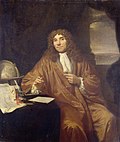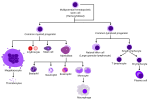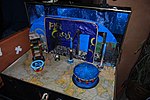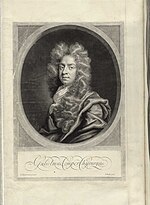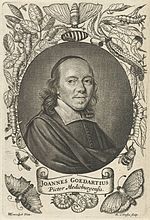Jan or Johannes Swammerdam (February 12, 1637 – February 17, 1680) was a Dutch biologist and microscopist. His work on insects demonstrated that the various...
26 KB (2,967 words) - 14:41, 3 December 2024
Van Leeuwenhoek's religion was "Dutch Reformed" and Calvinist. Like Jan Swammerdam he often referred with reverence to the wonders God designed in making...
49 KB (5,386 words) - 23:19, 23 December 2024
of the imaginal disc in insect development was first elucidated by Jan Swammerdam. During the pupal stage, many larval structures are broken down, and...
6 KB (702 words) - 06:09, 26 September 2024
Leuven (1658), Utrecht and Leiden (1663). There his co-students were Jan Swammerdam, Niels Stensen, Ole Borch and Frederik Ruysch, cooperating with professor...
16 KB (1,598 words) - 22:18, 18 August 2024
Thereafter, Giuseppe degli Aromatari and then Marcello Malpighi and Jan Swammerdam made observations using microscopes in the late 17th century, and interpreted...
17 KB (2,231 words) - 02:10, 1 June 2024
earliest people to observe red blood cells under a microscope, after Jan Swammerdam. His treatise De polypo cordis (1666) was important for understanding...
29 KB (3,745 words) - 07:59, 17 January 2025
Within a few months Steensen moved to Leiden, where he met the students Jan Swammerdam, Frederik Ruysch, Reinier de Graaf, Franciscus de le Boe Sylvius, a...
46 KB (4,729 words) - 16:58, 14 January 2025
1667, Jan Swammerdam, a Dutch anatomist famous for working with insects, struck the first important blow against the balloonist theory. Swammerdam, who...
5 KB (651 words) - 19:33, 21 April 2024
Insectis (Concerning Insect Animals) was published in 1602. Microscopist Jan Swammerdam published History of Insects, correctly describing the reproductive...
19 KB (1,894 words) - 00:05, 6 January 2025
Marcello Malpighi. In 1678, the red blood corpuscles was described by Jan Swammerdam of Amsterdam, a Dutch naturalist and physician. The first complete account...
22 KB (2,817 words) - 08:54, 5 December 2024
overview of a patient's general health status. In 1658 Dutch naturalist Jan Swammerdam was the first person to observe red blood cells under a microscope,...
10 KB (1,297 words) - 22:15, 26 December 2024
Nicolaus Bruhns, German organist and composer (d. 1718) February 12 – Jan Swammerdam, Dutch biologist and microscopist (d. 1680) February 13 – Denis Granville...
19 KB (2,206 words) - 16:31, 12 January 2025
November 2018. Walton, Richard E.; Sayer, Carl D.; Bennion, Helen; Axmacher, Jan C. (13 May 2020). "Nocturnal pollinators strongly contribute to pollen transport...
31 KB (3,115 words) - 16:40, 14 January 2025
Varro Avicenna Girolamo Fracastoro Marcello Malpighi Athanasius Kircher Jan Swammerdam Robert Hooke Ilan Chet (born 1939), Israeli microbiologist, professor...
12 KB (505 words) - 15:39, 26 December 2024
pupal stage, which Harvey viewed as the perfect egg form. However, Jan Swammerdam conducted a dissection study and showed that pupal forms are not egg-like...
22 KB (2,635 words) - 03:51, 21 July 2024
Spectacles" (in French). 2023-11-13. Retrieved 2023-12-29. John Fullerton; Jan Olsson (2004). Allegories of Communication: Intermedial Concerns from Cinema...
12 KB (1,166 words) - 01:43, 22 December 2024
annual markets. In 1675 Jan Swammerdam visited the community. He had burned his study of the silkworm on her advice. Swammerdam traveled to Copenhagen...
10 KB (1,258 words) - 22:14, 18 July 2024
Bartholomeo Eustachius (1520–1574), Reinier de Graaf (1641–1673), Jan Swammerdam (1637–1680), and Frederik Ruysch (1638–1731). The modern method of embalming...
62 KB (7,909 words) - 12:26, 13 January 2025
the brain mechanisms responsible for circulating cerebrospinal fluid. Jan Swammerdam placed severed frog thigh muscle in an airtight syringe with a small...
42 KB (5,196 words) - 08:29, 2 November 2024
illustrations supported the findings of Francesco Redi, Marcello Malpighi and Jan Swammerdam. Butterflies were regarded as symbol for the human soul since ancient...
41 KB (4,307 words) - 11:18, 5 September 2024
specimen. Then, Van Leeuwenhoek re-discovered red blood cells (after Jan Swammerdam) and spermatozoa, and helped popularise the use of microscopes to view...
31 KB (3,699 words) - 15:02, 20 May 2024
efforts in the biological sciences, including invertebrate zoology. Jan Swammerdam, a Dutch microscopist, supported an effort to work for a 'modern' science...
14 KB (1,864 words) - 20:05, 11 September 2024
at all, but that they were commissioned by Jan Swammerdam (1637–1680) and that after his death Swammerdam's widow had sold them to Bidloo. Whatever the...
5 KB (615 words) - 00:35, 31 August 2024
first person to describe red blood cells was the young Dutch biologist Jan Swammerdam, who had used an early microscope in 1658 to study the blood of a frog...
65 KB (7,856 words) - 17:50, 12 November 2024
and mice stirred up no debate. The Dutch biologist and microscopist Jan Swammerdam rejected the concept that one animal could arise from another or from...
45 KB (4,724 words) - 04:41, 4 November 2024
January 1668. In 1669, about eighteen months after Goedaert’s death, Jan Swammerdam (1637–1680) published his book Historia Insectorum Generalis, in which...
7 KB (840 words) - 23:07, 14 April 2024
"Experiments concerning the motion of sap in trees, made this spring". Jan Swammerdam publishes Historia Insectorum Generalis in the Netherlands, explaining...
4 KB (437 words) - 16:44, 16 June 2024
(1632–1723), Dutch scientist and businessman, first microbiologist Jan Swammerdam (1637–1680), Dutch biologist and microscopist Nicolas Steno (1638–1686)...
20 KB (2,593 words) - 17:44, 27 February 2024
infusoria and the diversity of microscopic life. Investigations by Jan Swammerdam led to new interest in entomology and helped to develop techniques of...
133 KB (13,826 words) - 03:33, 6 January 2025
in a 1674 letter to the Proceedings of the Royal Society of London; Jan Swammerdam had described red blood cells some years earlier, but had not published...
54 KB (5,899 words) - 12:17, 11 December 2024


